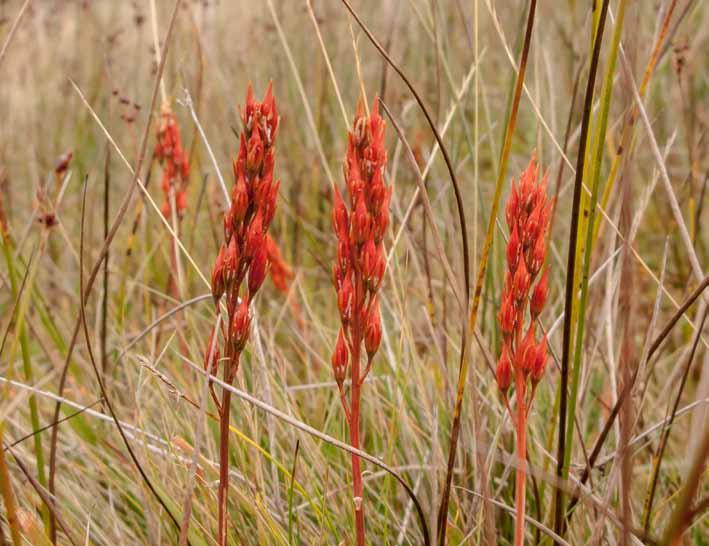
8 minute read
Mires of the Long Mynd: Part 1
Andrew Perry
Mires form the most botanically diverse parts of Long Mynd Site of Special Scientific Interest (SSSI), with 51 axiophytes recorded in monitoring plot data, along with eight nationally notable bryophytes. This article covers the vegetation of the sedge and valley mire communities, and in Part 2, I will discuss the vegetation around springs and soakaways. As an ecologist for the National Trust, I’ve been involved in monitoring these special habitats and I’ve tried to summarise some of the key information below. Data on mosses and liverworts are mostly taken from reports by Des Callaghan (2012–2014), detailed surveys commissioned by Natural England. Mires are usually dominated by combinations of sedges, rushes and bryophytes, and the composition of species can vary greatly depending on the water source, soil type, underlying geology, altitude, topography, grazing levels and geographic location. For a guide on separating the upland mire communities that occur in Shropshire see the article by Hilary Wallace in the spring 2013 newsletter, available via the Shropshire Botanical Society website.
Advertisement
Base-rich sedge mires
These occur where calcium-enriched but oligotrophic (nutrient-poor) water flushes the soil, and are an unexpected but welcome find on the Long Mynd. Despite most of the underlying geology being fairly acidic, the water is picking up dissolved bases from somewhere and water testing at such sites by Callaghan (2012) found an average pH of 7. These mires are often very small in extent, sometimes only a few square metres, but can be recognised by their short, patchy sward of small sedges scattered amongst ‘brown mosses’. Sphagna are rare in this habitat. On the Long Mynd, they occur at a range of altitudes from the foot slopes of Townbrook Hollow to the heads of the valleys on the plateau, wherever suitable water emerges from springs or seepages. Some of our less common sedges occur here including Dioecious Sedge Carex dioica, Flea Sedge Carex pulicaris and Tawny Sedge Carex hostiana. Carnation Sedge Carex panicea is the most frequent, usually accompanied by Glaucous Sedge Carex flacca, Common Yellow Sedge Carex demissa and Common Sedge Carex nigra. Joined Rush Juncus articulatus, Bulbous Rush Juncus bulbosus and Common Cottongrass Eriophorum angustifolium are common, and less frequently calcicoles (calcium-loving plants) such as Fewflowered Spike-rush Eleocharis quinqueflora and Quaking Grass Briza media can be found. Notable herbs include the sticky and carnivorous Common Butterwort Pinguicula vulgaris, Bog Pimpernel Anagallis tenella, Marsh Valerian Valeriana dioica, Lousewort Pedicularis sylvatica and Marsh Lousewort Pedicularis palustris (although I’ve yet to find the latter!). Of the bryophytes, Scorpidium mosses are abundant (mostly S. cossonii here), along with Bryum pseudotriquetrum, Ctenidium molluscum, Calliergonella cuspidata, Campylium stellatum, Philonotis fontana and Aneura pinguis. In terms of National Vegetation Classification (NVC), these mires as best described as M10
Bog Pimpernel and Scorpidium moss (Peter and Jane Howsam)
Carex dioica - Pinguicula vulgaris mire. This is predominantly a community of north-western Britain, commonly on limestone or other base-rich substrates (Rodwell, 1991). However, there are some notable differences in the Long Mynd type: P. vulgaris and C. dioica occur at a lower frequency; Anagallis tenella is frequent, which does not feature in the NVC floristic table for M10; Mat-grass Nardus stricta is more common; Lesser Clubmoss Selaginella selaginoides doesn’t occur in this region, and; Long-stalked Yellow Sedge Carex lepidocarpa, which is rare in the county (Lockton and Whild, 2015), is replaced by C. demissa. The latter substitution has been reported to occur in less base-rich stands and at higher altitudes (Elkington et al., 2001), and is frequent in M10a, the Carex demissa – Juncus bulbosus sub-community. The original NVC sampling only recorded M10a in the far north of England and in Scotland, although it has been reported to occur on Hope Bowdler and Caer Caradoc (Holland, 2011) where stands were lacking C. dioica and had lower frequencies of Brum pseudotriquetrum and Aneura pinguis. Whilst the Long Mynd stands also have the increased presence of Juncus bulbosus in M10a, they also share some similarities with the more calcicolous M10 samples with higher frequencies of Carex flacca, Briza media, Euphrasia sp., Bryum pseudotriquetrum, Ctenidium molluscum, Calliergonella cuspidata, and grassland species such as Autumn Hawkbit Scorzoneroides autumnalis, Self-heal Prunella vulgaris and Yorkshire Fog Holcus lanatus. This extends to other grassland plants not in the NVC table for M10 including Daisy Bellis perennis, White Clover Trifolium repens and Crested Dog’s-tail Cynosurus cristatus, possibly reflecting the lower altitude of our mires, historic grazing levels or sampling issues. Scorpidium scorpoides occurs at a reduced frequency on the Long Mynd examples. Despite the variation in these Shropshire Hills stands, the uniting feature is the abundance of Anagallis tenella and they were best described by Hilary Wallace (2013) as a southern expression of M10 that requires further study. Such examples


Round-leaved Sundew (Peter and Jane Howsam)
may also be present in Wales and the Peak District (Iain Diack, pers. comm.). Other sedge communities that lack formal definition also occur on the Long Mynd, which Des Callaghan referred to as ‘neutral flush’. He describes these as: “somewhat intermediate between M6 and M10, and frequently occurs with them in mosaics. It is typically a short-sedge community (e.g. Carex nigra, C. echinata and C. hostiana) with a strong presence of Sphagnum contortum, and is the principal habitat occupied by Hamatocaulis vernicosus”. The latter is a legally protected moss, and the nationally scarce Sphagnum platyphyllum was also recorded in the community.
Valley mires
The majority of the mires on the Long Mynd are dominated by rushes and can form extensive areas in valleys, or narrow linear flush lines on steeper ground. These are mostly acidic habitats and Sphagnum mosses are common. In the NVC they are mostly covered by the M6 Carex echinataSphagnum fallax/denticulatum mire and the M23 Juncus effusus/acutiflorus-Galium palustre rush-pasture communities. On the Long Mynd they are both usually dominated by Soft Rush Juncus effusus, but in M6 it grows amongst acidloving species such as Star Sedge Carex echinata and Tormentil Potentilla erecta, over a carpet of Sphagnum (usually S. fallax or S. flexuosum, often with S. palustre), and hummocks of Polytrichum commune. M23 is characteristic of higher nutrient status than M6, with plants such as Holcus lanatus, Marsh Bedstraw Galium palustre and Greater Bird’s-foot Trefoil Lotus pedunculatus, and without the more acidic mosses. However, this distinction is not always so apparent on the Long Mynd where the two communities often merge and form mosaics in the valleys. The abundance of J. effusus in the Long Mynd mires is likely a result of historic overgrazing and burning, with the M23 possibly representing a degraded form of M6 (Iain Diack, pers. comm.). M6b, the Nardus stricta sub-community, is present where rushes are less frequent and N. stricta grows amongst Sphagna and Carex echinata, C. nigra, C. panicea and C. pulicaris. The Long Mynd M6 is often lacking in species , although more distinctive stands can occur in places such as Catbatch, Wildmoor and Colliersford Gutter where Purple Moor-grass Molinia caerulea, Bog Asphodel Narthecium ossifragum and Eriophorum angustifolium can occur locally, and more rarely with Hare’s-tail Cottongrass Eriophorum vaginatum and Round-leaved Sundew Drosera rotundifolia. This north-western side of the plateau has a more substantial cover of peat (over 1m deep in places), whereas the majority of the Long Mynd has mineral soils with a much reduced peat cover. However, the fly-catching D. rotundifolia is also present in the eastern valleys, often near seepages at lower altitudes. In a few places around Wildmoor and the upper reaches of Catbatch, Juncus effusus is replaced by Juncus acutiflorus (M6d) and can be joined by Marsh Violet Viola palustris and Bogbean Menyanthes trifoliata. Bog pools also occur in this area with Sphagnum fallax and S. cuspidatum which were recorded by Des Callaghan as M2b. Wildmoor Pool is fringed with dense stands of Bottle Sedge Carex rostrata which emerge from the Sphagna, this is the M4 Carex rostrata – Sphagnum fallax mire. Sedges can be common in other communities below springs on the Long Mynd, but I’ll discuss those more in the next newsletter. For further reading on upland plant communities, I can recommend “An Illustrated Guide to British Upland Vegetation” (Averis et al., 2004). Acknowledgements: many thanks to Peter and Jane Howsam for sharing their photographs; to Iain Diack for comments on the draft article; and to Martin Godfrey for assistance with bryophyte identification.
References
Averis, A., Averis, B., Birks, J., Horsfield, D., Thompson, D. & Yeo, M. (2004) An Illustrated Guide to British Upland Vegetation. JNCC, Peterborough, ISBN 1 86107 553 7 Callaghan, D. (2012) Bryophytes and vegetation communities of springs and flushes on The Long Mynd (Shropshire). An unpublished report by EcoStudy to Natural England Callaghan, D. (2013) Bryophytes of The Long Mynd SSSI: survey, assessment and monitoring. An unpublished report by EcoStudy to Natural England Callaghan, D. (2014) Bryophyte survey of parts of The Long Mynd, Shropshire. An unpublished report by EcoStudy to Natural England Elkington, T., Dayton, N., Jackson, D.L. & Strachan, I.M. (2002) National Vegetation Classification field guide to mires and heaths. JNCC, Peterborough, ISBN 1 86107 526 X Holland, T. (2011) ‘Hope Bowdler and Caer Caradoc Spring and Flush Vegetation’, Shropshire Botanical Society Newsletter, No.23 (autumn), pp. 9-14 Lockton, A. & Whild, S (2015) The Flora & Vegetation of Shropshire. Shropshire Botanical Society, Shrewsbury. ISBN 978-0-9530937-2-4. Rodwell, J.S. (ed.) (1991) British Plant Communities. Volume 2. Mires and heaths. Cambridge University Press. Wallace, H. (2013) ‘Upland Mires’, Shropshire Botanical Society Newsletter, No.26 (spring), pp. 20-23








